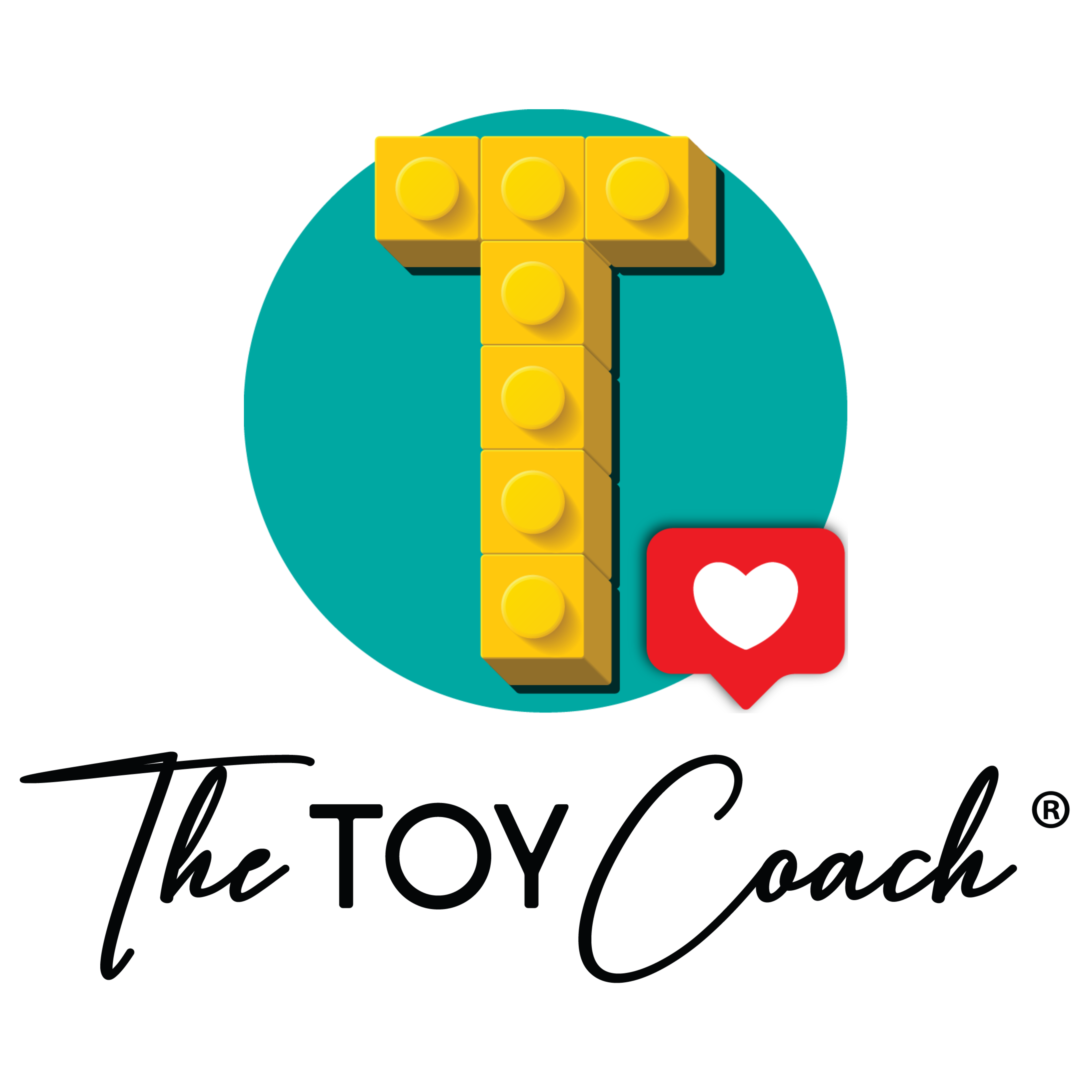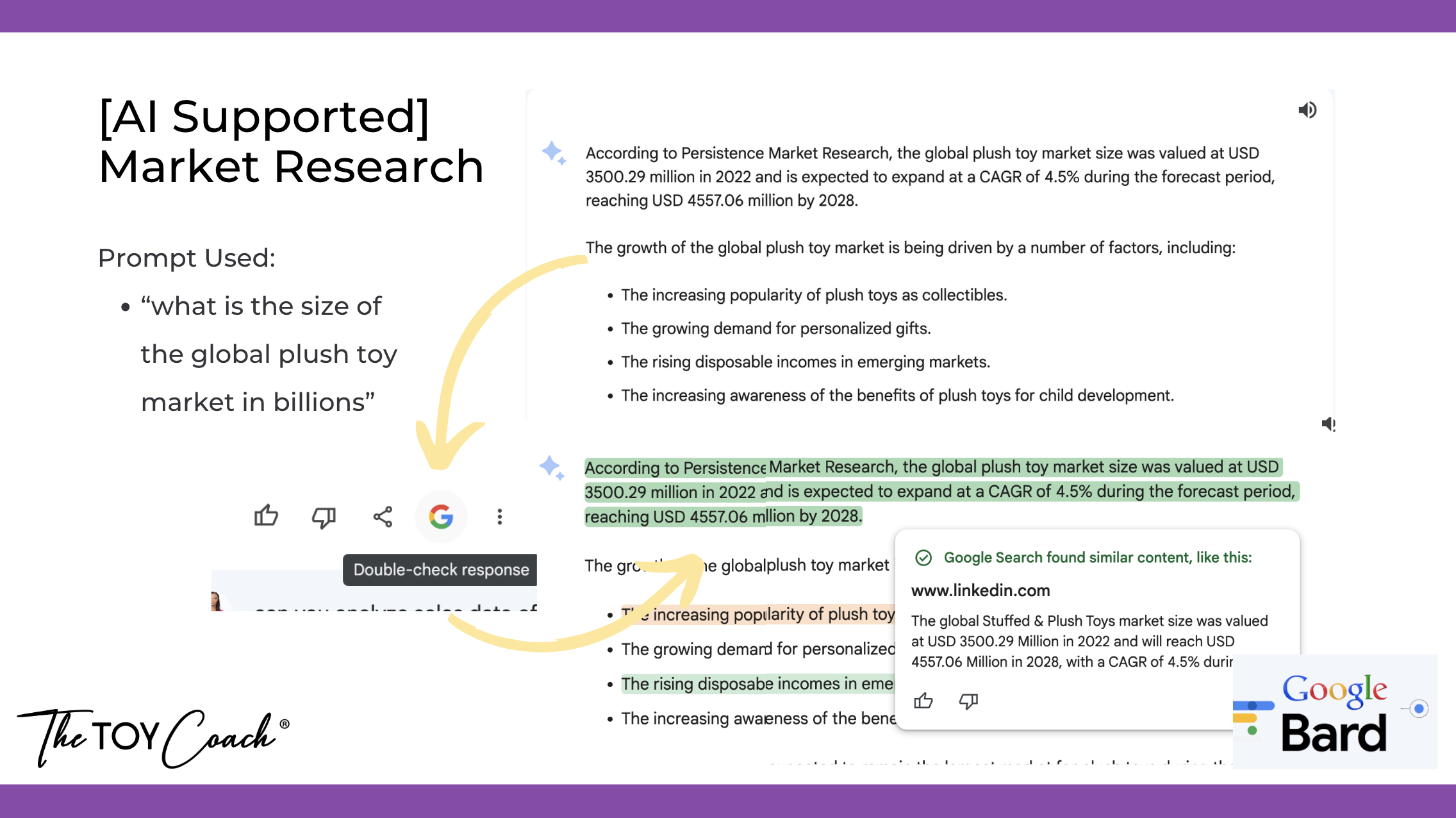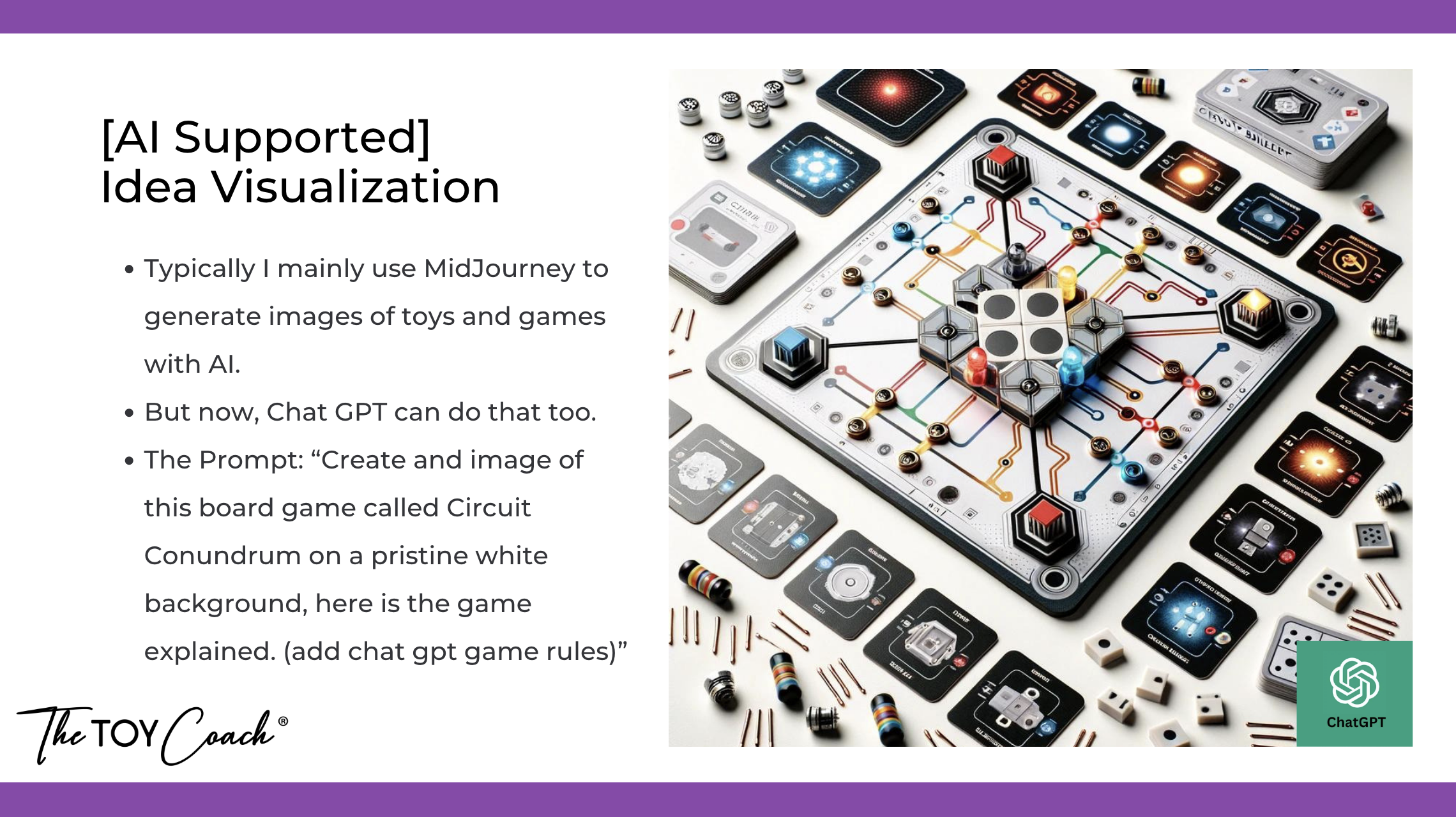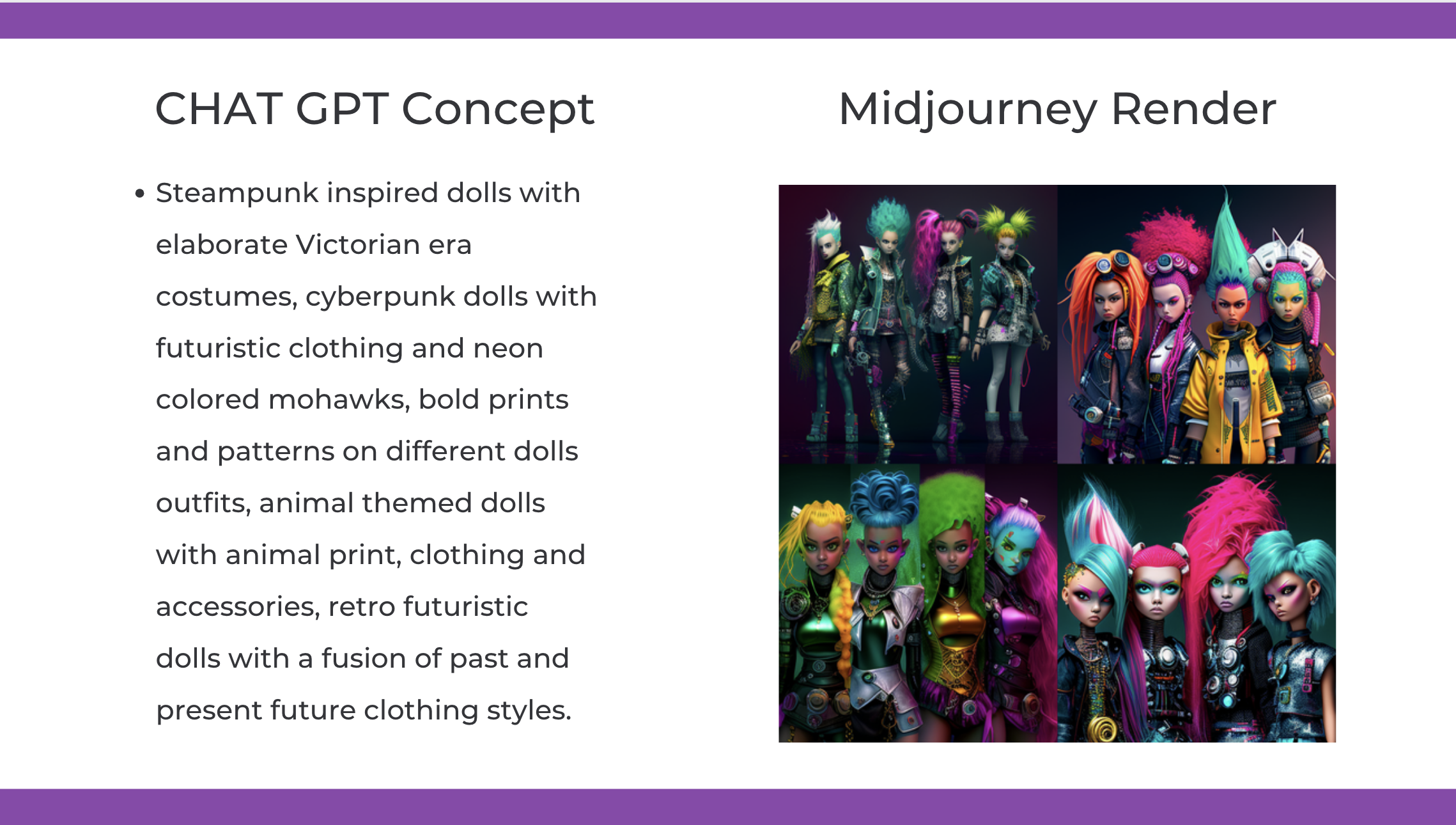Azhelle Wade, The Toy Coach - AI and the Future of Toy Invention
by Azhelle Wade | 30 Nov 2023
Industry Commentary, Op-Ed


AI and the Future of Toy Invention
The toy industry is constantly evolving, and with the emergence of artificial intelligence (AI), the process of inventing new toys is changing rapidly. AI can be used to speed up the toy invention process by automating many of the tasks involved in creating a new toy. AI tools can be used to research the market, generate ideas for new toys, visualize those ideas, and create pitches for toy companies. So let’s break down how AI can be used to assist in the toy creation process, starting from toy market research and leading to pitching that idea.
AI for Toy Market Research
The journey of toy invention begins with a deep understanding of the aspirations and desires of children. Traditionally, this involved delving into vast troves of data, attending industry events, and conducting surveys – a time-consuming and labor-intensive endeavor. AI, however, has emerged as an indispensable partner, streamlining this process into a seamless exploration of trends and opportunities.
AI tools can be used to scour the internet for data on toy sales, consumer trends, and popular toy categories. This data can then be analyzed to identify trends and opportunities in the market. For example, AI can be used to identify which types of toys are selling well, which demographics are buying the most toys, and which trends are emerging in the toy industry.
Google Bard is a powerful tool that can be used to assist in toy market research. By using Google Bard, toy companies can gain valuable insights into the toy market and develop new products that are sure to be a hit with kids. This AI tool can analyze large amounts of data to identify trends in the toy market, such as which types of toys are selling well, which demographics are buying the most toys, and what trends are emerging in the toy industry. Bard can be used to generate new toy ideas based on a variety of factors, such as the age group of the target audience, the desired play pattern, and the available materials. Bard can be used to analyze competitor products to identify strengths and weaknesses, and to develop a competitive differentiation strategy. Bard can be used to develop marketing materials, such as product descriptions, social media posts, and advertising copy.

Here’s how to use Google Bard for toy market research:
- Create a Google Bard account: If you don't already have a Google Bard account, you can create one for free.
- Go to the Google Bard website: Once you have a Google Bard account, you can go to the Google Bard website and sign in.
- Type your query into the search bar: Once you are signed in, you can type your query into the search bar. For example, you could type "What are the latest trends in the toy industry?" or "What are some new toy ideas for toddlers?"
- Google Bard will generate a response: Google Bard will generate a response that is based on the information that it has access to. The response may include text, images, and links to other resources.
AI for Toy Concept Ideation
Once you have a good understanding of the market, you can start to generate ideas for new toys. Traditionally, this has been a creative process that has relied on the brainstorming skills of designers and marketers. However, AI can now be used to generate new toy ideas that are both creative and marketable.
AI tools can be used to generate new toy concepts based on a variety of factors, such as the age group of the target audience, the desired play pattern, and the available materials. AI can also be used to generate new toy designs that are based on existing toys.
Chat GPT can be used for toy concept ideation by generating new toy or game ideas based on a variety of factors, such as the age group of the target audience, the desired play pattern, and the available materials. For example, you could ask Chat GPT to generate ideas for new toys that are educational, promote physical activity, or are based on popular children's books or movies.
Additionally, Chat GPT can be used to refine existing toy ideas by providing feedback on the toy's design, functionality, and marketing potential. For example, you could ask Chat GPT to provide feedback on a toy prototype that you have developed.
But that's not all you can use Chat GPT to develop toy concepts that meet specific needs, such as toys that are designed for children with disabilities or toys that promote STEM learning. For example, you could ask Chat GPT to develop a toy concept that helps children learn about coding.

Here’s How To Use Chat GPT for toy concept ideation:
- Create a Chat GPT account: If you don't already have a Chat GPT account, you can create one for free.
- Go to the Chat GPT website: Once you have a Chat GPT account, you can go to the Chat GPT website and sign in.
- Type your query into the chat box: Once you are signed in, you can type your query into the chat box. For example, you could type "I need ideas for new toys for toddlers" or "I need feedback on my toy prototype."
- Chat GPT will generate a response: Chat GPT will generate a response that is based on the information that it has access to.
AI for Visualization
Once you have a promising toy idea, you need to visualize it so that you can communicate it to others. Traditionally, this has been done by creating sketches, prototypes, or 3D models. However, AI can now be used to create realistic visualizations of toys in a matter of seconds.
AI tools can be used to generate images and videos of toys based on a simple text description. These visualizations can be used to communicate the toy concept to others, such as potential investors, manufacturers, or retailers.
Chat GPT + DALL-E: A partnership between Chat GPT and DALL-E made it possible to use Chat GPTdirectly as an image generator to make high-quality images of your toy or game ideas just from a text description.
MidJourney: A Discord based AI image generator that can render images of your toy or game ideas so you can see what they would look like in real life, before ever making a prototype.

AI for Pitching
Once you have a toy prototype of your toy idea and you’re ready to go to market, you need to get ready to pitch your toy idea to potential buyers. Traditionally, this has been done by creating a PowerPoint presentation and presenting it to potential buyers in person. However, AI can now be used to create pitches that are more engaging and persuasive.
Beautiful.ai is an easy to use AI PowerPoint generator and can be a valuable tool for creating pitch decks for a toy or game idea. Its intuitive interface, powerful design tools, and extensive template library make it easy to create visually appealing and persuasive presentations that effectively communicate your idea to potential investors or partners.
AI tools like Chat GPT can also be used to generate scripts for pitches, create slide decks, and even deliver pitches in a natural and engaging way.
Ethics of AI-Generated Content
While AI can be a powerful tool for toy invention, it is important to use AI tools responsibly and to be aware of the ethical implications of using AI-generated content. One concern is that AI could be used to make fake toys or copy other people's ideas. It's important to use AI tools in a way that doesn't violate copyright laws.
One of the main concerns about AI-generated content is that it could be used to create counterfeit toys or toys that infringe on the intellectual property of others. It is important to use AI tools responsibly and to be aware of the potential for copyright infringement.
Another concern about AI-generated content is that it could be used to create toys that are harmful or offensive. It is important to use AI tools in a way that promotes creativity and innovation, while also avoiding creating toys that could be harmful to children or offensive to others.
Conclusion
AI is a rapidly evolving technology that has the potential to revolutionize the toy industry. By using AI tools responsibly, toy inventors can speed up the toy invention process, generate new ideas, create realistic visualizations, and develop more effective pitches. However, it is important to be aware of the ethical implications of using AI-generated content and to use AI tools in a way that promotes creativity and innovation while avoiding harm.
AI has the potential to revolutionize the toy industry in many ways. It can help toy inventors to:
- Research the market and identify trends
- Generate new toy ideas
- Create realistic visualizations of toys
- Develop effective pitches
- Navigate the ethical landscape of AI
By using AI responsibly, toy inventors can create toys that are both innovative and marketable, and that will bring joy and laughter to children for generations to come.
About the Author
Azhelle Wade is a 3x patented toy industry inventor and educator with over 13 years of experience in toy design and development. She is the founder of The Toy Coach, a company that provides education and consulting services to toy inventors and entrepreneurs. She is also the host of the Making It in The Toy Industry podcast, which discusses the latest trends and developments in the toy industry.
If you’d like to learn more about how AI can be used in the toy industry, or to book Azhelle for a speaking engagement about AI in the toy industry, please visit https://thetoycoach.com/ai
Related Product
Recent Blogs
Recent Blogs

General
McHALE DESIGN CASE STUDY: MONSTERVERSE- THE LEGEND CONTINUES…

General
Build-A-Bear Celebrates National Teddy Bear Day with Donation to The Toy Foundation™

Industry Commentary, Op-Ed
Toy Foundation Auction is Now Open for Your Bids

Industry Commentary, Op-Ed
Bracelets, Stickers, and Viral Fame: The Story Behind Sky Castle Toys’ Sticki Rolls

Biographies and Interviews
Chrissy Fagerholt: Luck is when Preparation Meets Opportunity!
See more
Recent Wiki

BOOK REVIEWS
Book Review: Storm: Dawn of a Goddess by Tiffany D. Jackson

BOOK REVIEWS
Book Review: Erno Rubik and his Magic Cube by Kerry Aradhya

BOOK REVIEWS
Game Review: Trip Chaser

COMPANIES
Learning Express Toys Hosts 25th Annual Convention & Toy Expo at JW Marriott Tucson

MISCELLANEOUS
Submit Your LA Showroom Details for 2025 Toy Previews
See more
POP's Got Talent

POP Entertainment
Randy Klimpert Shares his Ukulele Collection

POP Entertainment
Steve Casino Peanut Art

POP Entertainment
Everyone's Talking about POP!

POP Entertainment
Princess Etch - a Multi-Talented Etch A Sketch Artist

POP Entertainment
Joseph Herscher of Joseph' s Machines.
See more
Recent POPcast

Hidden Role: The Brains Behind your Favorite Games
Connie Vogelmann designed Apiary & Wyrmspan!

Hidden Role: The Brains Behind your Favorite Games
Bob Fuhrer... Is THE Crocodile Dentist!

Hidden Role: The Brains Behind your Favorite Games
Tom Dusenberry... Bought Atari, Wizards of the Coast, and Avalon Hill!

Hidden Role: The Brains Behind your Favorite Games
Matt Leacock created Pandemic... the game!

Hidden Role: The Brains Behind your Favorite Games
Scott Brown and Tim Swindle... are Launching a New Sport!
See more
POPDuos

POPDuos: Interviews with Legends and Leaders
POPDuo: Richard Dickson, Mattel’s President & COO, and Kedar Narayan, Young Inventor Challenge AMB

POPDuos: Interviews with Legends and Leaders
POPDuo: Will Shortz and Josh Wardle

POPDuos: Legends and Leaders Explore Creativity
POP Duo: Elan Lee, Co-Founder, Exploding Kittens.and Jeff Probst, Host and Exec Producer, Survivor

POPDuos: Legends and Leaders Explore Creativity
POP Duo: David Fuhrer, MNG Director, Blue Sq Innovations & Shawn Green, past Dodgers & Mets MLB Star

POPDuos: Legends and Leaders Explore Creativity
POP Duo: Bob Fuhrer, Founder, Nextoy and Tom Fazio, Golf Course Designer
See more














